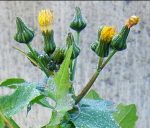
Also known as common sowthistle, milk thistle, and several other names, annual sowthistle is a member of the aster family, Asteraceae, that also includes dandelions, yarrow, and lettuce. It is native to Eurasia and North Africa but was introduced into the US and now occurs in all of the contiguous states. Plants prefer full or partial sun with moist to slightly dry, fertile soil and are found in a variety of sites such as fields, pastures, croplands, roadsides, gardens, vacant lots construction sites and waste places.
Description: Growing one to four feet tall, annual sowthistle and has a stout taproot and a hairless, hollow five angled stem that branches near the top and is dull green sometimes with a reddish purple tint. The thin soft alternate leaves are hairless, dull green on top, sometimes tinted reddish purple at the base, and are up to eight inches long but decrease in size as they ascend. They have deep triangular lobes with toothed margins ending with small, soft prickles and clasp the stem with claw-like basal lobes. Both the stem and leaves contain a milky sap. The flower heads appear from summer into fall in small terminal clusters and open during the morning, closing by noon. They are 3/4″ across and consist of numerous yellow ray flowers subtended by dull green, hairless, overlapping floral bracts. The fruit is a dark, ribbed, achene with a tuft of soft fluffy hairs that aids in wind dissemination. A single plant can produce 4,000 to 5,000 seeds that are viable for up to eight years or more. Plants spread by seed.
Control:Mulch to inhibit seed germination. Hoe or pull seedlings as they appear. Dig, cut or mow larger plants before seed set. Mowing is particular useful because root fragments do not sprout. Although annual sowthistle is resistant to some herbicides, glyphosates are effective but must be used carefully so as to avoid contact with desirable species.
Photo Credit: Wikipedia